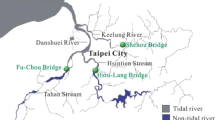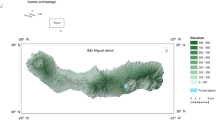Abstract
Seasonal rivers are the main sources of discharge for many lakes and reservoirs. These rivers can deliver pollutants into these water bodies, especially during large events. The fate and distribution of these pollutants within lakes is difficult to predict. Here, a three-dimensional, finite-volume model for predicting lake water quality is used to account for internal advection and diffusion, including the impacts of the inflowing rivers on the velocity field. We used parsimonious sub-models for the source/sink terms for temperature, dissolved oxygen, ammonia nitrogen, phosphorous, phytoplankton, and zooplankton concentrations and tested the model predictions against field measurements from the Chahnimeh Reservoir in Iran. The modeled water quality parameters were in good agreement with the measured values. Results were notably poorer when the three-dimensionality of the model was removed. This study suggests that properly simulating three-dimensional advection is important to properly predict the distribution of pollutants within some lakes and reservoirs and that this model may be directly applicable to systems similar to Chahnimeh Reservoir.











Similar content being viewed by others
References
Burger, D. F., Hamilton, D. P., & Pilditch, C. A. (2008). Modeling the relative importance of internal and external nutrient loads on water column nutrient concentrations and phytoplankton biomass in a shallow polymictic lake. Ecological Modeling, 211, 411–423.
Olli, G., Darracq, A., & Destouni, G. (2009). Field study of phosphorous and retention in drainage reaches. Journal of Hydrology, 365, 46–55.
Lefebvre, S., Bacher, C., Meuret, A., & Hussenot, J. (2001). Modeling nitrogen cycling in a mariculture ecosystem as a tool to evaluate its outflow. Estuarine, Coastal and Shelf Science, 52, 305–325.
Kuo, J. T., Hiseh, P. H., & Jou, W. S. (2008). Lake eutrophication management modeling using dynamic programming. Journal of Environmental Management, 88, 677–687.
Imberger, J., & Patterson, J. C. (1981). A dynamic reservoir simulation model—DYRESM: 5. In H. B. Fischer (Ed.), Transport models for inland and coastal waters (pp. 310–361). Waltham: Academic Press.
Antonopoulos, V. Z., & Gianniou, S. K. (2003). Simulation of water temperature and dissolved oxygen distribution in lake Vegoritis, Greece. Ecological Modeling, 160, 39–53.
Romero, J. R., Antenucci, J. P., & Imberger, J. (2004). One- and three-dimensional biogeochemical simulation of two differing reservoirs. Ecological Modeling, 174, 143–160.
Mirbagheri, S. A., Hashemi Monfared, S. A., & Masrorakis, N. (2008). Nutrient transport model in Chahnimeh manmade reservoirs. WSEAS Transactions on Environment and Development, 5(1), 44–54.
Boegman, L., Loewen, M. R., Hamblin, P. F., & Culver, D. A. (2001). Application of a two-dimensional hydrodynamic reservoir model to Lake Erie. Canadian Journal of Fisheries and Aquatic Sciences, 58, 858–869.
Jin, K. R., & Ji, Z. G. (2005). Application and validation of three-dimensional model in shallow lake. Journal Of waterway, Port, Coastal and Ocean Engineering, ASCE, 131(5), 213–225.
Holland, P., Kay, A., & Botte, V. (2003). Numerical modeling of thermal bar and its ecological consequences in a river-dominated lake. Journal of Marine Systems, 43, 61–81.
Rivera, E. C., Queiroz, J. F., Ferraz, J. M., & Ortega, E. (2007). System models to evaluate eutrophication in the Broa Reservoir, Sao Carlos, Brazil. Ecological Modeling, 202, 518–526.
Asare, O. D. A., Marr, I. L., & Cresser, M. S. (1999). Evaluation of cycling patterns of dissolved oxygen in a tropical lake as an indicator of biodegradable organic pollution. Science of the Total Environment, 231, 145–158.
Arhonditsis, G. B., & Brett, M. T. (2005). Eutrophication model for lake Washington (USA). Part Ι. Model description and sensitivity analysis. Ecological Modeling, 187, 140–178.
Arhonditsis, G. B., & Brett, M. T. (2005). Eutrophication model for lake Washington (USA). Part ΙΙ. model calibration and system dynamics analysis. Ecological Modeling, 187, 179–200.
Cugier, P., Billen, G., Guillaud, J. F., Garnier, J., & Menesguen, A. (2005). Modeling the eutrophication of the Seine Bight (France) under historical, present and future riverine nutrient loading. Journal of Hydrology, 304, 381–396.
Li-Jiao, Y., Wei-min, Q., & Xiao-hui, Z. (2004). Prediction and setup of phytoplankton statistical model of Qiandaohu Lake. Journal of Zhejiang University Science, 5(10), 1206–1210.
Walter, M., Recknagel, F., Carpenter, C., & Bormans, M. (2001). Predicting eutrophication effects in the Burrinjuck Reservoir (Australia) by means of the deterministic model SALMO and the recurrent neural network model ANNA. Ecological Modeling, 146, 97–113.
Omlin, M., Reichert, P., & Foster, R. (2001). Biogeochemical model of Lake Zürich: model equations and results. Ecological Modeling, 141, 77–103.
Bonnet, M. P., & Poulin, M. (2002). Numerical modeling of the planktonic succession in a nutrient-rich reservoir: environmental and physiological factors leading to Microcystis aeruginosa dominance. Ecological Modeling, 156, 93–112.
Rukhovets, L. A., Astrakhantsev, G. P., Menshutkin, V. V., Minina, T. R., Petrova, N. A., & Poloskov, V. P. (2003). Development of Lake Ladoga ecosystem models: modeling of the phytoplankton succession in the eutrophication process. Ecological Modeling, 165, 49–77.
Kagalou, I., Papastergiadou, E., & Leonardos, I. (2008). Long term changes in eutrophication process in a shallow Mediterranean lake ecosystem of W. Greece: response after the reduction of external load. Journal of Environmental Management, 87, 497–506.
Mieleitner, J., & Reichert, P. (2008). Modeling functional groups of phytoplankton in three lakes of different tropic state. Ecological Modeling, 211, 279–291.
Balistrieri, L. S., Tempel, R. N., Stillings, L. L., & Shevenell, L. A. (2006). Modeling spatial and temporal variations in temperature and salinity during stratification and overturn in Dexter Pit Lake, Tuscarora, Nevada, USA. Applied Geochemistry, 21, 1184–1203.
Gelda, R. K., Brooks, C. M., Effler, S. W., & Martin, T. A. (1999). International variations in nitrification in a hypereutrophic urban lake: occurrences and implications. Water Research, 34(4), 1107–1118.
Xu, F., Jorgensen, S. E., Taoa, S., & Li, B. (1999). Modeling the effects of ecological engineering on ecosystem health of a shallow eutrophic Chinese lake (Lake Chao). Ecological Modeling, 117, 239–260.
Krivtsov, V., Goldspink, C., Sigee, D. C., & Bellinger, E. G. (2001). Expansion of the model “Rostherne” for fish and zooplankton: role of top-down effects in modifying the prevailing pattern of ecosystem functioning. Ecological Modeling, 138, 153–171.
Muhammetoglu, A., & Soyupak, S. (2000). A three dimensional water quality macrophyte interaction model for shallow lakes. Ecological Modeling, 133, 167–180.
Bowie, G.L., Mills, W.B., Porcella, D.B., Campbell, L.C., Pagenkopf, J.R., Rupp, G.L., Johnson, K.M., Chan, P.W.H., Gherini, S.A. (1985) Rates, constants and kinetics formulations in surface water quality modeling. Second edition, EPA/600/3-85/040
Wunderlich, W. O. (1972). Heat and mass transfer between a water surface and the atmosphere. Tennessee Valley Authority, Laboratory report 14. Report No. 0–6803
Mirbagheri, S. A., & Tanji, K. K. (1981). Sediment characterization and transport modeling in Colusa Basin Drain. Davis: Department of Land, Air and Water Resources, University of California. Water Science and Engineering Papers.
Trancoso, A. R., Saraiva, S., Fernandes, L., Pina, P., Leitao, P., & Neves, R. (2005). Modeling macroalgae using a 3D hydrodynamic-ecological model in a shallow, temperate estuary. Ecological Modeling, 187, 232–246.
Jayaweera, M., & Asaeda, T. (1996). Modeling of biomanipulation in shallow, eutrophic lakes: an application to Lake Bleiswijkse Zoom, the Netherlands. Ecological Modeling, 85, 113–127.
Acknowledgments
The authors would like to express their sincere thanks to Dr. Todd Walter for the invaluable advices and comments. Gratitude is extended to the laboratory of Sistan and Baluchestan Rural Water and Wastewater Office for providing us with the access to the water samples.
Author information
Authors and Affiliations
Corresponding author
Rights and permissions
About this article
Cite this article
Hashemi Monfared, S.A., Mirbagheri, S.A. & Sadrnejad, S.A. A Three-Dimensional, Integrated Seasonal Separate Advection–Diffusion Model (ISSADM) to Predict Water Quality Patterns in the Chahnimeh Reservoir. Environ Model Assess 19, 71–83 (2014). https://doi.org/10.1007/s10666-013-9376-0
Received:
Accepted:
Published:
Issue Date:
DOI: https://doi.org/10.1007/s10666-013-9376-0




